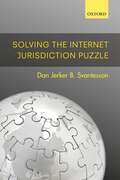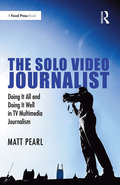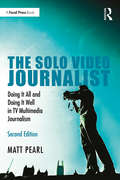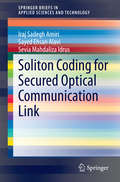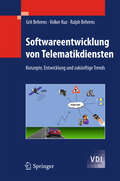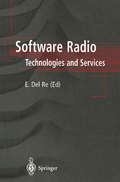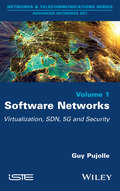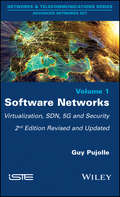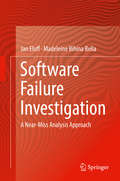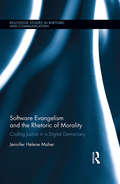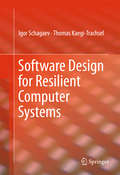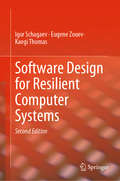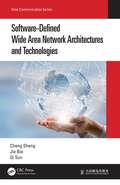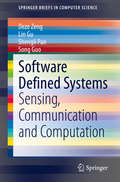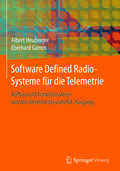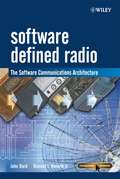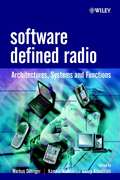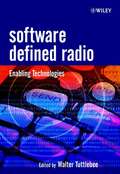- Table View
- List View
Solving the Internet Jurisdiction Puzzle
by Dan Jerker SvantessonInternet jurisdiction has emerged as one of the greatest and most urgent challenges online; affecting areas as diverse as e-commerce, data privacy, law enforcement, content take-downs, cloud computing, e-health, cyber security, intellectual property, freedom of speech, and cyberwar. In this innovative book, Professor Svantesson presents a vision for a new approach to Internet jurisdiction based on an extensive period of research dedicated to the topic. The book demonstrates that our current paradigm remains attached to territorial thinking that is out of sync with our modern world, especially, but not only, online. Having made the claim that our adherence to the territoriality principle is based more on habit rather than on any clear and universally accepted legal principles, Professor Svantesson advances a new jurisprudential framework for how we approach jurisdiction - a framework that unites private, and public, international law. He also proposes several other reform initiatives aimed at equipping us to solve the Internet jurisdiction puzzle. In addition, the book provides a history of Internet jurisdiction, and challenges our traditional categorisation of different types of jurisdiction. It places Internet jurisdiction in a broader context and outlines methods for how to properly understand and work with rules of Internet jurisdiction. While Solving the Internet Jurisdiction Puzzle paints a clear picture of the concerns involved and the problems that needs to be overcome, this book is distinctly aimed at finding practical solutions anchored in a solid theoretical framework. Professor Svantesson argues that many of the Internet jurisdiction problems we face are due to a sleepwalking-like acceptance of orthodox thinking. Solving the Internet Jurisdiction Puzzle acts as a wake-up call to this issue.
The Solo Video Journalist: Doing It All and Doing It Well in TV Multimedia Journalism
by Matt PearlIt is becoming increasingly important for television reporters to be proficient in many, if not all, of the steps in production. The Solo Video Journalist will make handling all these responsibilities seem possible, and do so from the hands-on perspective of a current reporter with years of experience as a multimedia journalist. This book will cover all aspects of multimedia journalism, from planning for a segment, to dressing appropriately for one’s multiple roles, to conducting interviews and editing. The instruction and guidance in this text will help make readers valuable players in their field, and it is filled with real-world examples and advice from current professionals. Whether it be college students learning from the ground up or journalists early in their careers, The Solo Video Journalist ensures they will have all the materials they need to be successful multimedia journalists.
The Solo Video Journalist: Doing It All and Doing It Well in TV Multimedia Journalism
by Matt PearlIt is becoming increasingly important for television reporters to be proficient in many, if not all, of the steps in production. The Solo Video Journalist will make handling all these responsibilities seem possible, and do so from the hands-on perspective of a current reporter with years of experience as a multimedia journalist. This book will cover all aspects of multimedia journalism, from planning for a segment, to dressing appropriately for one’s multiple roles, to conducting interviews and editing. The instruction and guidance in this text will help make readers valuable players in their field, and it is filled with real-world examples and advice from current professionals. Whether it be college students learning from the ground up or journalists early in their careers, The Solo Video Journalist ensures they will have all the materials they need to be successful multimedia journalists.
The Solo Video Journalist: Doing It All and Doing It Well in TV Multimedia Journalism
by Matt PearlThe Solo Video Journalist, now in its second edition, offers a comprehensive overview of the solo video reporting process from start to finish. Drawing from years of professional experience in the field, the author covers all aspects of multimedia journalism, from planning for a segment, to dressing appropriately for multiple roles, to conducting interviews, and editing. The book contains interviews with more than a dozen top storytellers from around the United States and offers practical advice for how to succeed in a growing media field. New to this edition are Career Chronicles – chapters that detail the career paths possible for modern journalists – and a fully updated chapter on the importance of building a digital and social media presence. This book is an excellent resource for students learning skills in broadcast, multimedia, backpack, and television journalism, as well as for early-career professionals looking for a back-pocket resource in solo video journalism.
The Solo Video Journalist: Doing It All and Doing It Well in TV Multimedia Journalism
by Matt PearlThe Solo Video Journalist, now in its second edition, offers a comprehensive overview of the solo video reporting process from start to finish. Drawing from years of professional experience in the field, the author covers all aspects of multimedia journalism, from planning for a segment, to dressing appropriately for multiple roles, to conducting interviews, and editing. The book contains interviews with more than a dozen top storytellers from around the United States and offers practical advice for how to succeed in a growing media field. New to this edition are Career Chronicles – chapters that detail the career paths possible for modern journalists – and a fully updated chapter on the importance of building a digital and social media presence. This book is an excellent resource for students learning skills in broadcast, multimedia, backpack, and television journalism, as well as for early-career professionals looking for a back-pocket resource in solo video journalism.
Soliton Coding for Secured Optical Communication Link (SpringerBriefs in Applied Sciences and Technology)
by Iraj Sadegh Amiri Sayed Ehsan Alavi Sevia Mahdaliza IdrusNonlinear behavior of light such as chaos can be observed during propagation of a laser beam inside the microring resonator (MRR) systems. This Brief highlights the design of a system of MRRs to generate a series of logic codes. An optical soliton is used to generate an entangled photon. The ultra-short soliton pulses provide the required communication signals to generate a pair of polarization entangled photons required for quantum keys. In the frequency domain, MRRs can be used to generate optical millimetre-wave solitons with a broadband frequency of 0–100 GHz. The soliton signals are multiplexed and modulated with the logic codes to transmit the data via a network system. The soliton carriers play critical roles to transmit the data via an optical communication link and provide many applications in secured optical communications. Therefore, transmission of data information can be performed via a communication network using soliton pulse carriers. A system known as optical multiplexer can be used to increase the channel capacity and security of the signals.
Softwareentwicklung von Telematikdiensten: Konzepte, Entwicklung und zukünftige Trends (VDI-Buch)
by Grit Behrens Volker Kuz Ralph BehrensDas Buch vermittelt einen Einstieg in die Software-Entwicklung von Telematikdiensten mit einem Eclipse-Plugin für das Common Service Framework (Open Source). Ziel ist es, Nutzer dazu zu befähigen, internetbasierte Telematikdienste selbst zu programmieren. Begleitend zum Buch steht ein Internetportal bereit, wo Beispielapplikationen demonstriert, getestet oder weiter entwickelt werden können. Es gibt des Weiteren Einblick in die Hintergründe und die weltweiten Zukunftsentwicklungen auf dem rasant anwachsenden Gebiet der Telematikdienste.
Software Radio Architecture: Object-Oriented Approaches to Wireless Systems Engineering
by Joseph Mitola IIIA software radio is a radio whose channel modulation waveforms are defined in software. All wireless telephones are controlled by this software. Written by the leader in the field, this book covers the technology that will allow cellular telephones to greatly expand the types of data they can transmit.
Software Radio: Technologies and Services
by Enrico Del ReNext-generation mobile communications are likely to employ different techniques and standards. The implementation in software of as many receiver functionalities as possible appears to be the most effective solution for coping with the multiplicity of communications alternatives. The concept of software radio, dating back to 1991, originally attracted commercial interest owing to the possibility that transmission layer functions could be fully software-defined. The same approach can be extended to protocols of the higher layers too, thus conceiving a programmable hardware to implement the functionalities of several layers of protocols by resident software or software downloaded from the network. Consisting of selected technical contributions to the Workshop on "Software Radio", this volume deals with state-of-the-art surveys of the enabling technologies and the prospective services of software radio implementations for future mobile communications.Original and state-of-the-art research and development is presented in fields such as:- Software radio for universal wireless internet access- Software radio for multimedia communications- Software radio architecture- Network architecture, protocols and services - Software radio technology towards pervasive appliance.This volume on software radio is a valuable reference for both researchers and telecommunications professionals.
Software Networks: Virtualization, SDN, 5G and Security
by Guy PujolleThe goal of this book is to describe new concepts for Internet next generation. This architecture is based on virtual networking using Cloud and datacenters facilities. Main problems concern 1) the placement of virtual resources for opening a new network on the fly, and 2) the urbanisation of virtual resource implemented on physical network equipment. This architecture deals with mechanisms capable of controlling automatically the placement of all virtual resources within the physical network. In this book, we describe how to create and delete virtual networks on the fly. Indeed, the system is able to create any new network with any kind of resource (e.g., virtual switch, virtual routers, virtual LSRs, virtual optical path, virtual firewall, virtual SIP-based servers, virtual devices, virtual servers, virtual access points, and so on). We will show how this architecture is compatible with new advances in SDN (Software Defined Networking), new high-speed transport protocol like TRILL (Transparent Interconnection of Lots of Links) and LISP (Locator/Identifier Separation Protocol), NGN, IMS, Wi-Fi new generation, and 4G/5G networks. Finally, we introduce the Cloud of security and the virtualisation of secure elements (smartcard) that should definitely transform how to secure the Internet.
Software Networks: Virtualization, SDN, 5G and Security
by Guy PujolleThe goal of this book is to describe new concepts for Internet next generation. This architecture is based on virtual networking using Cloud and datacenters facilities. Main problems concern 1) the placement of virtual resources for opening a new network on the fly, and 2) the urbanisation of virtual resource implemented on physical network equipment. This architecture deals with mechanisms capable of controlling automatically the placement of all virtual resources within the physical network. In this book, we describe how to create and delete virtual networks on the fly. Indeed, the system is able to create any new network with any kind of resource (e.g., virtual switch, virtual routers, virtual LSRs, virtual optical path, virtual firewall, virtual SIP-based servers, virtual devices, virtual servers, virtual access points, and so on). We will show how this architecture is compatible with new advances in SDN (Software Defined Networking), new high-speed transport protocol like TRILL (Transparent Interconnection of Lots of Links) and LISP (Locator/Identifier Separation Protocol), NGN, IMS, Wi-Fi new generation, and 4G/5G networks. Finally, we introduce the Cloud of security and the virtualisation of secure elements (smartcard) that should definitely transform how to secure the Internet.
Software Networks: Virtualization, SDN, 5G, and Security
by Guy PujolleSoftware Networks describe new concepts for the Internet's next generation. This architecture is based on virtual networking using Cloud and datacenter facilities. The main problems to be dealt with are the placement of virtual resources for opening a new network on the fly, and the urbanization of virtual resources implemented on physical network equipment. The digital architecture also deals with mechanisms capable of automatically controlling the placement of all virtual resources within the physical network. This book describes how to create and delete virtual networks on the fly. Indeed, the system is able to create any new network with any kind of virtual resource (e.g. switches, routers, LSRs, optical paths, firewalls, SIP-based servers, devices, servers, access points, etc.). Software Networks shows how this architecture is compatible with new advances in SDN (Software Defined Networking), new high-speed transport protocols such as TRILL (Transparent Interconnection of Lots of Links) and LISP (Locator/Identifier Separation Protocol), NGN, IMS, new generation Wi-Fi, and 4G/5G networks. Finally, the author introduces Clouds of security and the virtualization of secure elements (smartcards) that could certainly transform how to secure the Internet. For this second edition, the author addresses in five new chapters the importance of open source software for networks, mobile edge computing, fog networking, tactile internet – a network environment allowing remote access, and security – the use of Cloud of security, secure elements and the emergence of the blockchain.
Software Networks: Virtualization, SDN, 5G, and Security
by Guy PujolleSoftware Networks describe new concepts for the Internet's next generation. This architecture is based on virtual networking using Cloud and datacenter facilities. The main problems to be dealt with are the placement of virtual resources for opening a new network on the fly, and the urbanization of virtual resources implemented on physical network equipment. The digital architecture also deals with mechanisms capable of automatically controlling the placement of all virtual resources within the physical network. This book describes how to create and delete virtual networks on the fly. Indeed, the system is able to create any new network with any kind of virtual resource (e.g. switches, routers, LSRs, optical paths, firewalls, SIP-based servers, devices, servers, access points, etc.). Software Networks shows how this architecture is compatible with new advances in SDN (Software Defined Networking), new high-speed transport protocols such as TRILL (Transparent Interconnection of Lots of Links) and LISP (Locator/Identifier Separation Protocol), NGN, IMS, new generation Wi-Fi, and 4G/5G networks. Finally, the author introduces Clouds of security and the virtualization of secure elements (smartcards) that could certainly transform how to secure the Internet. For this second edition, the author addresses in five new chapters the importance of open source software for networks, mobile edge computing, fog networking, tactile internet – a network environment allowing remote access, and security – the use of Cloud of security, secure elements and the emergence of the blockchain.
Software Failure Investigation: A Near-Miss Analysis Approach
by Jan Eloff Madeleine Bihina BellaThis book reviews existing operational software failure analysis techniques and proposes near-miss analysis as a novel, and new technique for investigating and preventing software failures. The authors provide details on how near-miss analysis techniques focus on the time-window before the software failure actually unfolds, so as to detect the high-risk conditions that can lead to a major failure. They detail how by alerting system users of an upcoming software failure, the detection of near misses provides an opportunity to collect at runtime failure-related data that is complete and relevant. They present a near-miss management systems (NMS) for detecting upcoming software failures, which can contribute significantly to the improvement of the accuracy of the software failure analysis. A prototype of the NMS is implemented and is discussed in the book. The authors give a practical hands-on approach towards doing software failure investigations by means of near-miss analysis that is of use to industry and academia
Software Evangelism and the Rhetoric of Morality: Coding Justice in a Digital Democracy (Routledge Studies in Rhetoric and Communication)
by Jennifer Helene MaherExamining the layers of meaning encoded in software and the rhetoric surrounding it, this book offers a much-needed perspective on the intersections between software, morality, and politics. In software development culture, evangelism typically denotes a rhetorical practice that aims to convert software developers, as well as non-technical lay users, from one platform to another (e.g., from the operating system Microsoft Windows to Linux). This book argues that software evangelism, like its religious counterpart, must also be understood as constructing moral and political values that extend well beyond the boundaries of the development culture. Unlike previous studies that locate such values in the effects of code in-use or in certain types of code like free and open source (FOSS) software, Maher argues that all code is meaningful beyond its technical, executable functions. To facilitate this analysis, this study builds a theory of evangelism and illustrates this theory at work in the proprietary software industry and FOSS communities. As an example of political liberalism at work at the level of code, these evangelical rhetorics of software construct competing conceptions of what is good that fall within a shared belief in what is just. Maher illustrates how these beliefs in goodness and justice do not always execute in replicable ways, as the different ways of decoding software evangelisms in the contexts of Brazil and China reveal. Demonstrating how software evangelisms exert a transformative force on the world, one comparable in significance to code itself, this book highlights the importance of rhetoric in even the most seemingly a-rhetorical of technical endeavors and foregrounds the crucial need for rhetorical literacy in the digital age.
Software Evangelism and the Rhetoric of Morality: Coding Justice in a Digital Democracy (Routledge Studies in Rhetoric and Communication)
by Jennifer Helene MaherExamining the layers of meaning encoded in software and the rhetoric surrounding it, this book offers a much-needed perspective on the intersections between software, morality, and politics. In software development culture, evangelism typically denotes a rhetorical practice that aims to convert software developers, as well as non-technical lay users, from one platform to another (e.g., from the operating system Microsoft Windows to Linux). This book argues that software evangelism, like its religious counterpart, must also be understood as constructing moral and political values that extend well beyond the boundaries of the development culture. Unlike previous studies that locate such values in the effects of code in-use or in certain types of code like free and open source (FOSS) software, Maher argues that all code is meaningful beyond its technical, executable functions. To facilitate this analysis, this study builds a theory of evangelism and illustrates this theory at work in the proprietary software industry and FOSS communities. As an example of political liberalism at work at the level of code, these evangelical rhetorics of software construct competing conceptions of what is good that fall within a shared belief in what is just. Maher illustrates how these beliefs in goodness and justice do not always execute in replicable ways, as the different ways of decoding software evangelisms in the contexts of Brazil and China reveal. Demonstrating how software evangelisms exert a transformative force on the world, one comparable in significance to code itself, this book highlights the importance of rhetoric in even the most seemingly a-rhetorical of technical endeavors and foregrounds the crucial need for rhetorical literacy in the digital age.
Software Design for Resilient Computer Systems
by Igor Schagaev Kaegi ThomasThis book addresses the question of how system software should be designed to account for faults, and which fault tolerance features it should provide for highest reliability. The authors first show how the system software interacts with the hardware to tolerate faults. They analyze and further develop the theory of fault tolerance to understand the different ways to increase the reliability of a system, with special attention on the role of system software in this process. They further develop the general algorithm of fault tolerance (GAFT) with its three main processes: hardware checking, preparation for recovery, and the recovery procedure. For each of the three processes, they analyze the requirements and properties theoretically and give possible implementation scenarios and system software support required. Based on the theoretical results, the authors derive an Oberon-based programming language with direct support of the three processes of GAFT. In the last part of this book, they introduce a simulator, using it as a proof of concept implementation of a novel fault tolerant processor architecture (ERRIC) and its newly developed runtime system feature-wise and performance-wise. The content applies to industries such as military, aviation, intensive health care, industrial control, space exploration, etc.
Software Design for Resilient Computer Systems
by Igor Schagaev Eugene Zouev Kaegi ThomasThis book addresses the question of how system software should be designed to account for faults, and which fault tolerance features it should provide for highest reliability. With this second edition of Software Design for Resilient Computer Systems the book is thoroughly updated to contain the newest advice regarding software resilience. With additional chapters on computer system performance and system resilience, as well as online resources, the new edition is ideal for researchers and industry professionals.The authors first show how the system software interacts with the hardware to tolerate faults. They analyze and further develop the theory of fault tolerance to understand the different ways to increase the reliability of a system, with special attention on the role of system software in this process. They further develop the general algorithm of fault tolerance (GAFT) with its three main processes: hardware checking, preparation for recovery, and the recovery procedure. For each of the three processes, they analyze the requirements and properties theoretically and give possible implementation scenarios and system software support required. Based on the theoretical results, the authors derive an Oberon-based programming language with direct support of the three processes of GAFT. In the last part of this book, they introduce a simulator, using it as a proof of concept implementation of a novel fault tolerant processor architecture (ERRIC) and its newly developed runtime system feature-wise and performance-wise. Due to the wide reaching nature of the content, this book applies to a host of industries and research areas, including military, aviation, intensive health care, industrial control, and space exploration.
Software-Defined Wide Area Network Architectures and Technologies (Data Communication Series)
by Cheng Sheng Jie Bai Qi SunStarting with problems and challenges faced by enterprise WANs, Software-Defined Wide Area Network Architectures and Technologies provides a detailed description of SD-WAN’s background and basic features, as well as the system architecture, operating mechanism, and application scenarios of the SD-WAN solution based on the implementation of Huawei SD-WAN Solution. It also explains key SD-WAN technologies and analyzes real SD-WAN deployment cases, affording readers with design methods and deployment suggestions for the SD-WAN solution. The information presented in this book is easy to understand and very practical. It enables you to become adept in the SD-WAN solution’s implementation and design principles. The book is intended for ICT practitioners, such as network technical support engineers, network administrators, and network planning engineers, to use in studying theory. Furthermore, it serves as reference material for network technology enthusiasts. Authors Cheng Sheng is the Chief Architect of Huawei’s SD-WAN Solution. He has nearly 20 years of experience in network product and solution design, as well as extensive expertise in product design and development, network planning and design, and network engineering project implementation. Jie Bai is an Architect of Huawei’s SD-WAN Solution. He is well versed in Huawei security products and SD-WAN Solution and has written books such as Huawei Firewall Technology Talk as well as Huawei Anti-DDoS Technology Talk. Qi Sun is a Senior Information Architect of Huawei, and he is knowledgeable in Huawei SD-WAN Solution, CloudVPN Solution, and Cloud Management Solution. He also participated in the information architecture design and delivery of multiple solutions.
Software-Defined Wide Area Network Architectures and Technologies (Data Communication Series)
by Cheng Sheng Jie Bai Qi SunStarting with problems and challenges faced by enterprise WANs, Software-Defined Wide Area Network Architectures and Technologies provides a detailed description of SD-WAN’s background and basic features, as well as the system architecture, operating mechanism, and application scenarios of the SD-WAN solution based on the implementation of Huawei SD-WAN Solution. It also explains key SD-WAN technologies and analyzes real SD-WAN deployment cases, affording readers with design methods and deployment suggestions for the SD-WAN solution. The information presented in this book is easy to understand and very practical. It enables you to become adept in the SD-WAN solution’s implementation and design principles. The book is intended for ICT practitioners, such as network technical support engineers, network administrators, and network planning engineers, to use in studying theory. Furthermore, it serves as reference material for network technology enthusiasts. Authors Cheng Sheng is the Chief Architect of Huawei’s SD-WAN Solution. He has nearly 20 years of experience in network product and solution design, as well as extensive expertise in product design and development, network planning and design, and network engineering project implementation. Jie Bai is an Architect of Huawei’s SD-WAN Solution. He is well versed in Huawei security products and SD-WAN Solution and has written books such as Huawei Firewall Technology Talk as well as Huawei Anti-DDoS Technology Talk. Qi Sun is a Senior Information Architect of Huawei, and he is knowledgeable in Huawei SD-WAN Solution, CloudVPN Solution, and Cloud Management Solution. He also participated in the information architecture design and delivery of multiple solutions.
Software Defined Systems: Sensing, Communication and Computation (SpringerBriefs in Computer Science)
by Deze Zeng Lin Gu Shengli Pan Song GuoThis book introduces the software defined system concept, architecture, and its enabling technologies such as software defined sensor networks (SDSN), software defined radio, cloud/fog radio access networks (C/F-RAN), software defined networking (SDN), network function virtualization (NFV), software defined storage, virtualization and docker. The authors also discuss the resource allocation and task scheduling in software defined system, mainly focusing on sensing, communication, networking and computation. Related case studies on SDSN, C/F-RAN, SDN, NFV are included in this book, and the authors discuss how these technologies cooperate with each other to enable cross resource management and task scheduling in software defined system. Novel resource allocation and task scheduling algorithms are introduced and evaluated. This book targets researchers, computer scientists and engineers who are interested in the information system softwarization technologies, resource allocation and optimization algorithm design, performance evaluation and analysis, next-generation communication and networking technologies, edge computing, cloud computing and IoT. Advanced level students studying these topics will benefit from this book as well.
Software Defined Radio-Systeme für die Telemetrie: Aufbau und Funktionsweise von der Antenne bis zum Bit-Ausgang
by Eberhard Gamm Albert HeubergerDieses Buch behandelt alle für ein Software Defined Radio (SDR) relevanten Systemteile: Antenne, Antennenanpassung, analoges Frontend, A/D-Umsetzung, Digital Downconversion (DDC), Interpolation, Synchronisation, Demodulation. Zunächst werden die notwendigen Grundlagen für die Darstellung von Signalen vermittelt sowie der gesamte Aufbau eines Software Defined Radios beschrieben, um anschließend die einzelnen Komponenten näher zu betrachten.Der Schwerpunkt des Buches liegt auf dem Zusammenspiel der Komponenten und Signale innerhalb des Empfängers. Zur Veranschaulichung der Signale wird das Open-Source-Programm GNU Octave verwendet.
Software Defined Radio: The Software Communications Architecture (Wiley Series in Software Radio #6)
by John Bard Vincent J. Kovarik JrThe Software Communications Architecture (SCA) establishes an implementation-independent framework for the development of Joint Tactical Radio System software configurable radios. It specifies the Operating Environment, services and interfaces that applications use. Software Defined Radio: The Software Communications Architecture focuses on the issues and benefits associated with developing a radio system in compliance with the SCA specification. This book provides a comprehensive, practical introduction to building a SCA-compliant system taking the reader through the historical and conceptual background to help filling in the gaps between the intent of the SCA specification and the practice. Key features: Presents a practical approach to the Software Communications Architecture Provides an example-oriented understanding of the usage of the SCA and thus allows the reader to extend the concepts and practice to more complicated multi-processor distributed environments. Covers the Operating Environment: a Core framework, CORBA middleware, POSIX operating systems and Domain profiles. Features an accompanying website with appendices, and links to further information on the SCA. This invaluable reference will provide applications programmers, designers, professional researchers, wireless manufacturers and operators with an indispensable guide to the Software Communications Architecture. Advanced undergraduate and postgraduate students on mobile and wireless communications courses will also find this to be an excellent guide to the topic.
Software Defined Radio: Architectures, Systems and Functions (Wiley Series in Software Radio)
by Markus Dillinger Kambiz Madani Nancy AlonistiotiSoftware defined radio (SDR) is a hot topic in the telecommunications field, with regard to wireless technology. It is one of the most important topics of research in the area of mobile and personal communications. SDR is viewed as the enabler of global roaming and a platform for the introduction of new technologies and services into existing live networks. It therefore gives networks a greater flexibility into mobile communications. It bridges the inter-disciplinary gap in the field as SDR covers two areas of development, namely software development and digital signal processing and the internet. It extends well beyond the simple re-configuration of air interface parameters to cover the whole system from the network to service creation and application development. Reconfigurability entails the pervasive use of software reconfiguration, empowering upgrades or patching of any element of the network and of the services and applications running on it. It cuts across the types of bearer radio systems (Paging to cellular, wireless local area network to microwave, terrestrial to satellite, personal communications to broadcasting) enable the integration of many of today's disparate systems in the same hardware platform. Also it cuts across generation (second to third to fourth). This volume complements the already published volumes 1 and 2 of the Wiley Series in Software Radio. The book discusses the requirements for reconfigurability and then introduces network architectures and functions for reconfigurable terminals. Finally it deals with reconfiguration in the network. The book also provides a comprehensive view on reconfigurability in three very active research projects as CAST, MOBIVAS and TRUST/SCOUT. Key features include: Presents new research in wireless communications Summarises the results of an extensive research program on software defined radios in Europe Provides a comprehensive view on reconfigurability in three very active research projects as CAST (Configurable radio with Advanced Sodftware Technology), MOBIVAS (Downloadable MOBIle Value Added Services through Software Radio and Switching Integrated Platforms), TRUST (Transparently Re-configurable Ubiquitous Terminal) and SCOUT (Smart User-Centric Communciation Environment).
Software Defined Radio: Enabling Technologies (Wiley Series in Software Radio)
by Walter H. W. TuttlebeeSoftware defined radio (SDR) is one of the most important topics of research, and indeed development, in the area of mobile and personal communications. SDR is viewed as an enabler of global roaming and as a unique platform for the rapid introduction of new services into existing live networks. It therefore promises mobile communication networks a major increase in flexibility and capability. SDR brings together two key technologies of the last decade - digital radio and downloadable software. It encompasses not only reconfiguration of the air interface parameters of handset and basestation products but also the whole mobile network, to facilitate the dynamic introduction of new functionality and mass-customised applications to the user's terminal, post-purchase. This edited book, contributed by internationally respected researchers and industry practitioners, describes the current technological status of radio frequency design, data conversion, reconfigurable signal processing hardware, and software issues at all levels of the protocol stack and network. The book provides a holistic treatment of SDR addressing the full breadth of relevant technologies - radio frequency design, signal processing and software - at all levels. As such it provides a solid grounding for a new generation of wireless engineers for whom radio design in future will assume dynamic flexibility as a given. In particular it explores * The unique demands of SDR upon the RF subsystem and their implications for front end design methodologies * The recent concepts of the 'digital front end' and 'parametrization' * The role and key influence of data conversion technologies and devices within software radio, essential to robust product design * The evolution of signal processing technologies, describing new architectural approaches * Requirements and options for software download * Advances in 'soft' protocols and 'on-the-fly' software reconfiguration * Management of terminal reconfiguration and its network implications * The concepts of the waveform description language The book also includes coverage of * Potential breakthrough technologies, such as superconducting RSFQ technology and the possible future role of MEMS in RF circuitry * Competing approaches, eg all-software radios implemented on commodity computing vs advanced processing architectures that dynamically optimise their configuration to match the algorithm requirements at a point in time The book opens with an introductory chapter by Stephen Blust, Chair of the ITU-R WP8F Committee and Chair of the SDR Forum presenting a framework for SDR, in terms of definitions, evolutionary perspectives, introductory timescales and regulation. Suitable for today's engineers, technical staff and researchers within the wireless industry, the book will also appeal to marketing and commercial managers who need to understand the basics and potential of the technology for future product development. Its balance of industrial and academic contributors also makes it suitable as a text for graduate and post-graduate courses aiming to prepare the next generation of wireless engineers.
